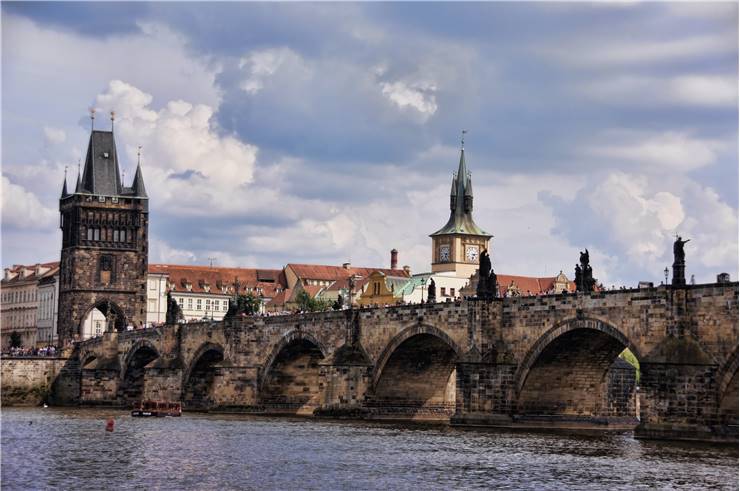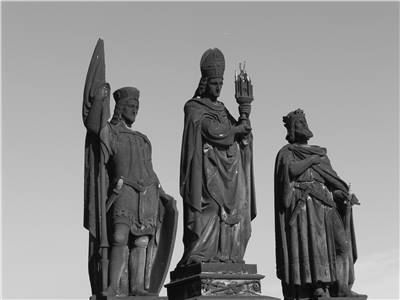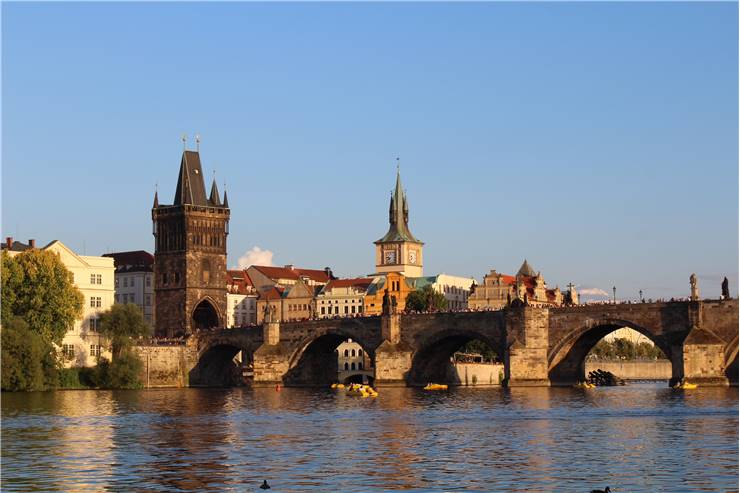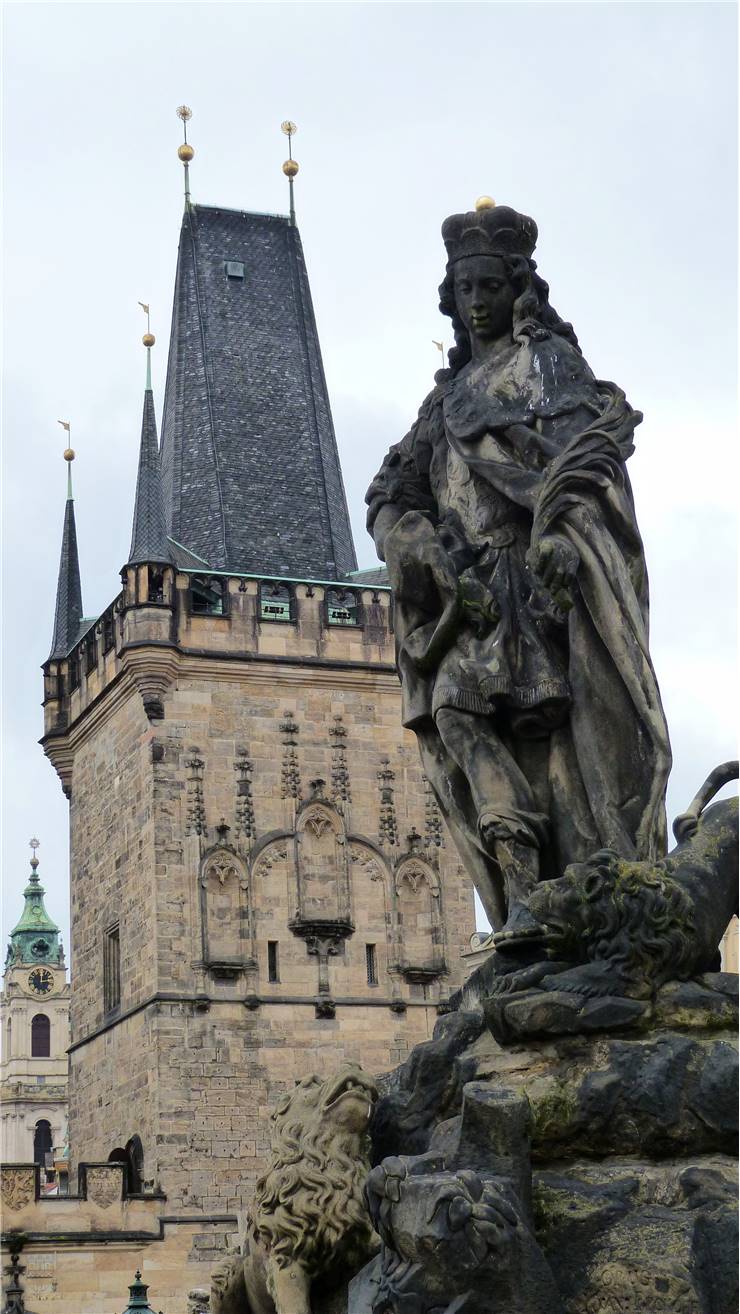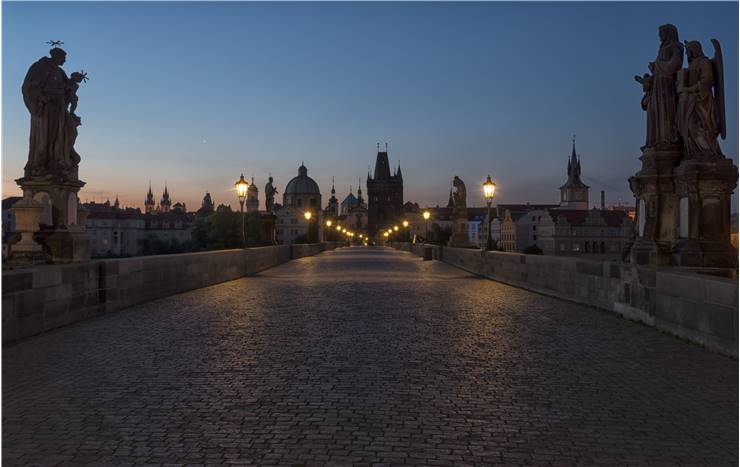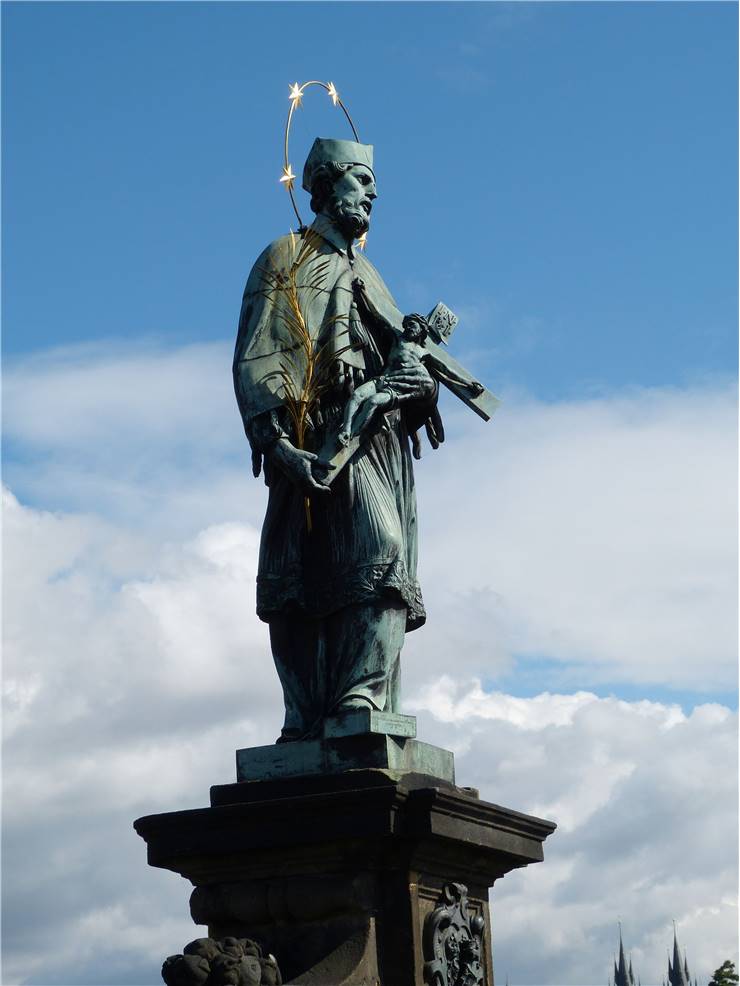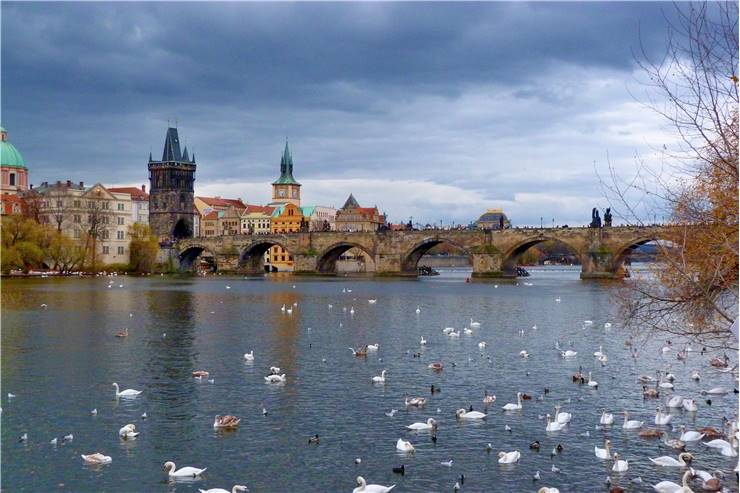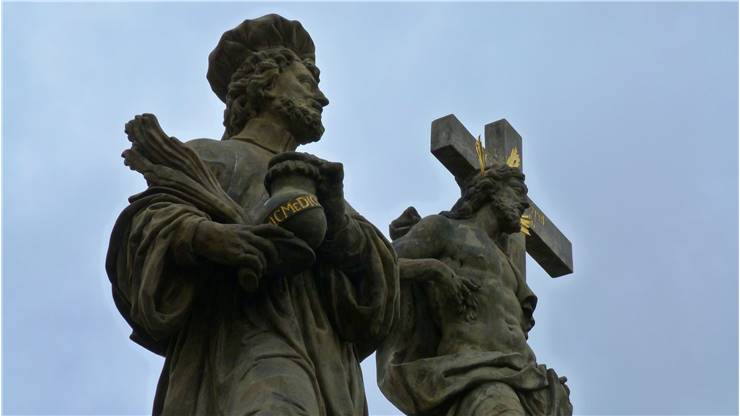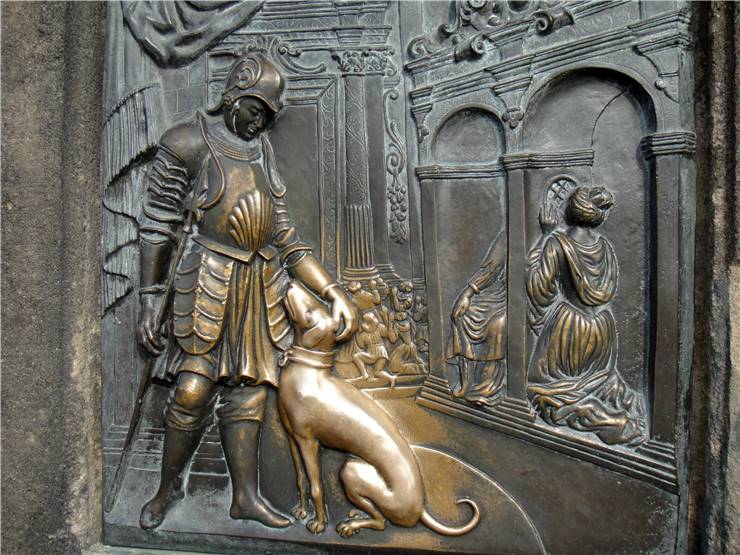Charles Bridge - History, Statues, Towers, Legends
Charles Bridge is not only one of the most praised bridge in the history of Czech Republic but is also one of the most famous bridges in entire Europe. Built over the Vltava river in Prague in 1402 under the commission of the Charles IV (1316-1378), King of Bohemia and Holy Roman Emperor, this bridge completely replaced the old wooden Judith Bridge that served the citizen of Prague between 1172 and 1342, after which it was destroyed in flood. Contracted under the oversight of architects Master Otto and Peter Parler, this bridge fully entered the public use in 1402 under the name Stone Bridge and Prague Bridge. It became known to the world as Charles Bridge only in 1870.
Over several centuries, Charles Bridge served as the only means of crossing Vltava River in this region of Czech Republic, providing invaluable service in connecting the Prague Castle and the Prague city with the surrounding area and the remainder of Europe. As one of the only reliable river crossing in the entire region, Charles Bridge played an important role in boosting the commerce and transportation all around the city of Prague. During its long history, the bridge adapted to many types of use, being briefly used for trams, carrying armies, and in recent times being entirely dedicated to pedestrian use.
Construction of the bridge out of the strong Bohemian sandstone lasted 45 long years, during which this 515-meter-long and nearly 10-meter-wide bridge was slowly constructed using 16 arches that look almost identical in size. However, they differ in size between being 16.6 and 23 meters long, with nicely tapered piers that add to the look of the bridge. Similarly, like many other medieval bridges that were used as apart of city defense, Charles Bridge was protected by three towers that still stand to this day. One of them, the Old Town Bridge Tower is today considered to be one of the most beautiful Gothic-style buildings in the entire world.
Over the centuries, this bridge received praises for its strength and durability, but one of its defining characteristics was its undeniable beauty. Even though it was designed intentionally to look very simple from both afar and to walk on it (with very simple decking and side guardrails), the bridge received international fame for its inclusion of 30 statues of baroque-style that were added around 1700, but are now almost all replaced with replicas.
With the span of over 500 meters and 16 long arches, this bridge is described by many as the most beautiful bridge in the world
Today, Charles Bride is pedestrianized and protected as one of the most coveted historical and cultural icons of the modern Czech Republic. It is visited by millions of tourists every year, and it is regularly promoted in various pieces of media, including popular Hollywood films.
Judith Bridge – Predecessor of Charles Bridge
The celebrated Charles Bridge was not the first bridge that stood at this location of Vltava River. Much before its time, old Prague Town used a simple wooden structure to span the length of the wide river. This wooden bridge was described in history as a very simple, small, and was essentially used only for foot traffic and very light transport of goods with horses. It was so narrow that carts were unable to fit on it. This wooden bridge served the residents of old Prague until it was destroyed in the flood of 1157. Confronted with the lack of passage, King Vladislav II ordered the creation of the first stone bridge across the Vltava. Built between 1160 and 1172, this new bridge managed to effortlessly span the Vltava River using a structure that was 514 meters long, seven meters wide, and with 27 low but sturdy arches. The finished bridge was named by the wife of King Vladislav II, Judith. Judith Bridge and the surrounding defensive towers continued to be in use for two centuries, with its administration eventually falling into the hands of the Knights of the Cross. However, the bridge did not manage to reach the years of European Renaissance. Two-thirds of it were destroyed in the large flooding of Vltava River in 1342.
The remains of the Judith Bridge remain to this day. Pieces of the original construction and destroyed arches are still on the bottom of the Vltava River, and one of its small defensive towers on the Malá Strana side of Charles Bridge has managed to survive also. Previously used as a monastery, this tower is today used as a museum.
The finished Charles Bridge also carries a commemoration to the old Judith Bridge. It is said that sculpture of a bearded man at the side of the bridge represents an architect and a builder who created Judith Bridge. This statue is used to this day to gauge the water levels of Vltava.
Charles Bridge Towers
As the only wide and strong crossing point of the Vltava, kings of old Prague invested considerable resources in fortifying the long Charles Bridge. In middle ages, this was a very common occurrence for many other large bridges that were built on important trade routes, in big cities or near castles.
Charles Bridge is surrounded by three towers, one of the Old Town side (Staromestska mostecka vez) and two on the Lesser Quarter ( Malá Strana) side.
Since it was created at the end of the 14th century by the architect Peter Parler (who also finished the construction of the Charles Bridge itself), the Old Town Tower has been considered to be one of the most impressive Gothic buildings in the entire world. It’s majestic look, and strong defenses have defined the area around the Charles Bridge. This impressive tower is decorated not only with signature design elements of Gothic architecture, but also with three sculptures – King Charles of Bohemia and The Emperor of the Holy Roman Empire (who commissioned the building of the bridge),St Vitus (the protector saint of the Charles Bridge) and Wenceslas IV (predecessor of the King Charles). Today, visitors of this tower can experience tourist guides and the short film presentation that can be experienced on the first floor of the tower depicting the influences of astronomical and astrological relations that led to the creation of some elements of the bridge and its towers.
On the Lesser Quarter side, the bridge is guarded by two smaller towers. The older one is a Romanesque-style tower that was created for the protection of the older Judith Bridge that fell into the Vltava after large flooding in 1342. The surviving tower served several roles over past centuries, being used at one time as a monastery. Today it is a home of one of many museums found in Prague. The other tower was created in 1464, well after Charles Bridge was finished. This tower, also designed by famous Czech architect Peter Parler, features exquisite Gothic styling and high balconies that offer an incredible view of Charles Bridge and the surrounding area of Prague.
All three towers of Charles Bridge today are open to the public.
Old Bridge Tower that protects one side of the Charles Bridge is regarded by many as one of the most impressive Gothic structures ever created
Charles Bridge Construction
The planning for the building of Charles Bridge was formed shortly after the large flooding of Vltava River destroyed reliable and by then quite an essential Judith Bridge that stood in the center of Prague between 1172 and 1342. The new bridge was envisioned to be stronger, wider, and with more reinforced guard gates that would be built on both ends of the bridge.
The Czech legend says that the Charles IV, Holy Roman Emperor, and benefactor who commissioned the construction of the bridge laid the first stone on 9 July 1357. He perceived that date as the astrological sign that would imbue the bridge with additional strength.
The overall construction of the bridge lasted for 45 years, with prolonged delays due to construction issues,lack of resources, and constant problem of flooding.
The primary construction material of the bridge are bocks of Bohemian sandstone that were bound together with what is still considered to be an unusually strong mortar. The exact formula of this mortar is not known today, but many speculate that one possible secret ingredient was powder ground out of eggshells. Strong stone was the only possible material that could be used for the creation of long-lasting bridge, with tensile capacity that can easily withhold the forces that are created in arched designs. Also, the Bohemian stone was easily accessible and could be quickly transported from quarries to the construction site. The use of arches was preferred by many architects because ordinary buildings made of stone (like forts or castles) require a lot of settling, but arched structures do not.
The original design of the bridge was devised by the Master Otto, and was later continued by Peter Parler, celebrated architects of Czech masterpiece buildings such as St Wenceslas Chapel in St Vitus Cathedral and The Old Town bridge tower. The core design of the bridge included 16 spans (sized between 16 and 24 meters), two strong abutments on both ends of the bridge and series of piers along the length of the bridge, built to reinforce the support of the arches. Abutments of the bridge were reinforced, and atop of them, Peter Parler built two defensive towers (with the nearby old third one surviving the destruction of Judith Bridge). New towers were built in Gothic style from Bohemian sandstone blocks that were very similar to those used in the construction of the bridge itself. Piers of the bridge were shaped to face toward the flow of the water, protecting the bridge against the water and objects in it (most dangerously, uprooted trees, pieces of wooden buildings and large ice blocks). Stone piers are sized to around 8 by 24 meters and are also protected by the secondary construction of wooden ice-breakers. Decking of the Charles Bridge is around 9.5-meter-wide, and it does not flow straight across the river. It has small zig-zag shape and is raised above the primary decking, enabling water to flow away from the top of the bridge via passive water drain system.
No concrete evidence of the construction process exists, but historians have made numerous educated assumptions how the Charles Bridge was built. Since the bridge was built on site of the Judith Bridge, construction crews already had a foundation laid on the bottom of the river. Those old foundations were reinforced in a major way, with timber and stone walls enabling workers to divert the river from around foundation areas. Then, in dry, bridge piers were constructed and prepared for the expansion of arches. Arches were created with the help of falsework, a temporary framework created almost certainly from timber. Using that, masons expanded upon the foundations, slowly creating arches and the support for the bridge decking. 19th-century examination came to the conclusion that pillars and millstones were reinforced with the use of iron clamps on which hot lead was poured.
The construction process was heavily delayed by several floods, including one that happened just ten years after work started in 1367. This flood destroyed all the work on then uncomplete piers, and the following floods in 1639, 1367, 1370 and others also caused significant damages. After the bridge was completed, another flood in 1432 caused the rupture of the bridge in three spots. Fixing of this issue lasted for 71 years. The bridge was again damaged by floods and ice-buildup in 18th and 19th century. Repairs on the bridge were common, and new techniques were used to reinforce the piers of the bridge several times. The decking of the bridge was also changed several times, with the adoption of asphalt and train tracks being the most major events in its history.
Currently, the bridge is slated for another restoration which will be extensive and long-lasting. Planners are aiming for the start of the overhauling of the bridge decking, arches, and statues in late 2019, with the work lasting for around 20 years.
Charles Bridge up to the 20th century
Immediately after the bridge was finished, it started amassing both long-term damage and sudden large structural issues that pushed the city of Prague and its government to invest significant funds in regular maintenance and enhancing of the bridge with new construction methods that were developed over the next few centuries.
One of the core reasons why this bridge was so susceptible to damage from floods and buildup of ice was because it spanned very wide Vltava river with so many piers. Even though it allowed water to flow through under 16 of its arches, the piers still blocked significant part of the river, which led to the “clogging up” of the entire water stream below the bridge during violent floods that picked up thousands of pieces of wood (from houses near shore) and uprooted trees. Confronted with so much clutter, bridge support structures cracked several times, most notably in the large 1432 flood that damaged the bridge support in three of its pillars. Repair of this damage lasted astonishing 71 years.
In the 17th century, Charles Bridge was used several times during the state of war. Following the Battle of White Mountain, 27 elders anti-Habsburg revolt were executed, and the bridge served as a deterrent showcase. Heads of all the slain rebels were arranged on the bridge, deterring further revolt across Czech land. Almost three decades later in 1648, Swede armies captured Czech land on the west bank of Vltava. They laid siege on Prague and advanced into battle on the Charles bridge that was heavily protected by his towers. During that city battle, the heavies combat happened right on the bridge, leading to the significant damage to one of its towers. Following the conflict, almost all damaged exterior Gothic ornaments were removed and later replaced.
By the early 18th century, the bridge started morphing into its modern form that it still has to this day. Most importantly, this included the addition of the two rows of ornamental statues that were placed on both edges of the bridge. Created in the baroque style, statues instantly made Charles Bridge one of the most famous bridges in entire Europe. However, the bridge could not endure through 18th century without some heavy damage. Flood of 1784 damaged five of its pillars almost to the point of collapse of the bridge, but extensive repairs prevented this from happening.
During the 1840s, the bridge went through several notable events. The staircase between it and Vltava small Kampa Island was rebuilt, large flood lightly damaged the bridge, and no shells hit it during the Czech revolutionary days (some statues were damaged though). In the 2nd half of 19th century, the bridge received several upgrades – gaslight illumination, the establishment of the first regular public-transport line, and major reconstruction of the bridge towers. Two floods hit the bridge during those years – large 1872 flood that clogged the river below the bridge with an incredible amount of debris, and 1890 flood that damaged three arches and caused two pillars (and several statues above them) to collapse. The extensive repair of the bridge lasted for two years and was reopened in late 1892. Before the end of the century, the bridge received electric illumination.
At this point, Charles Bridge was almost 500 years old, but it will continue to morph over the following century.
Charles Bridge in 20th century
The tram line was removed during the 1800s, but horse lines continued to operate over the bridge all up to 1905 when the dramatic rise of traffic pushed the local government to install electric tram across the Charles Bridge. Electric tram operated just three years, after which it was replaced with busses. The bridge was not damaged during World War I, and World War II (which was a minor miracle, because Prague was captured by both Germans and Russians during WWII), and only notable change was the addition of the new barricade that was built beside Old Town bridge tower gateway.
Even though it was damaged numerous times by floods and sieges, it managed to survive World War II almost untouched when the city was besieged by both Germans and Russians
The only major reconstruction work on the Charles Bridge during 20th century happened between 1965 and 1978, which included reinforcement of pillars, replacement of broken stones, and removal of the decking asphalt and installing stone mosaic surface. Since the finishing of those works, the bridge was adapted to be used only by pedestrians, with no vehicles being allowed on it.
However, during 1990s public sentiment started growing that bridge was not restored properly and that many imperfections remained. The sentiment grew additionally after bridge survived flooding 2002 with very little damage. The resulting plan for the gradual 2008-2010 reconstruction included overall polish of the look of the bridge and fixing of the only two pillars that were not touched after 1980 flood repairs. This latest reconstruction included additions such as a new hydro isolation system that prevented deep water damage, new decking pavement, replacement of many stones (which was not done properly, causing visual imperfections and social issues raised in the press).
A new wave of extensive and costly repairs is scheduled to start in 2019 and last around 20 years.
Charles Bridge Statues – Baroque Statues
Between 1683 and 1714, Charles Bridge was decorated with the two rows of statues that decorate entire 500+ meter span of the bridge. Created by some of the greatest sculptors in Czech history (such as Matthias Braun, Jan Brokoff, Michael Joseph and Ferdinand Maxmilian), these statues depict various saints and patron saints that were venerated at that time in Prague. Beautiful, artistic and high-quality brass statues made in a baroque style immediately managed to boost the city’s popularity and cultural importance of this bridge all around the world.
Because of the numerous structural issues and restorations that this bridge received since the early 1700s,some statues were destroyed, and eventually many of were replaced by copies. In addition to these two rows of main statues, side-statue of the mythical Bohemian knight Bruncvík is located on a side column that originally hosted the statue of Knight Roland that was badly damaged in 1648. Bruncvík statue was sculpted much later, in 1884.
Statues on Charles Bridge are separated in two rows on north and south side of the bridge. The following list presents the statues in the order when crossing the bridge from the Old Town to the Lesser Quarter.
Northside statues of Charles Bridge
- Statue of the Madonna attending to St. Bernard – Sculpted by Matěj Václav Jäckl in 1709, commissioned by the donation of Benedikt Littwerig, an abbot of the Cistercian monastery in Osek.
- Statue of the Madonna, Ss. Dominic and Thomas Aquinas – A group statue that depicts Madonna, St. Dominic and St Thomas Aquinas. Sculpted by the Matěj Václav Jäckel in 1708 under commission from Dominicans Convent of St. Giles in the Old Town of Prague.
- The Crucifix and Calvary – Statue that gathered a lot of controversy during the ages. Originallycreated even before Charles Bridge was erected, the modern version of the statue was created in 1623, and was remade in metal in 1657. Prague eldership forced oppressed Jewish people to decorate the statue with gold, as a symbol of the humiliation and degradation of Prague Jews.
- Statue of St. Anne – Sculpted by Matěj Václav Jäckel in 1707 under the commission of count Rudolf of Lisov, the hetman of the New Town of Prague. The statue depicts mother of the young Virgin Mary, who was depicted in this statue as a young girl.
- Statue of St. Cyril and St. Methodius – Sculpted by Karel Dvořák between 1928 and 1939, under the commission of the Czech Ministry of Education. It portrays two missionaries who introduced Christianity to the Slavs. The place of this statue was filled with a statue of St. Ignatius, which was displaced by the 1890 floods and was transferred to the National Museum of Prague.
- Statue of St. John the Baptist – Sculpted by Josef Max in 1857, by the commission of a Norbert Gemrich of Neuberk. Originally, this place on the bridge held the statue “Baptism of Jesus” by Jan Brokoff which was showcased on the bridge between 1706 and 1848.
- Statue of Saints Norbert of Xanten, Wenceslas, and Sigismund - Sculpted in 1853 by Josef Max, under the patronage of the Dr. Jeroným Zeidler, an abbot of Strahov Monastery.
- Statue of St. John of Nepomuk – One of the most popular and the oldest statue that is still standing on the Charles Bridge. It was sculpted by Jan Brokoff in 1683.
- Statue of St. Anthony of Padua – Sculpted by Jan Oldřich Mayer in 1707 under the patronage of councilor of the Prague Castle burgraviate, Krištof Mořice Withauer. It depicts St. Anthony holding Jesus while standing between two vases.
- Statue of St. Jude Thaddeus – Sculpted by Jan Oldřich Mayer in 1708 and paid for by the knight Mitrovský from Nemyšle and Jeřichovice, František Sezima. The statue depicts St. Jude holding a rod.
- Statue of St. Augustine – Sculpted by Jan Bedřich Kohl in 1708 and paid for by Augustinian convent of St. Thomas in Prague. The statue depicts a philosopher holding a hook and a burning heart, with an accompanying angel beside him.
- Statue of St. Cajetan – Sculpted by Ferdinand Brokoff in 1709 under the sponsorship of convent of Theatins in Prague. The statue depicts St. Cajetan, a founder of the religious order of Theatins.
- Statue of St. Philip Benitius – Designed and sculpted by Michal Bernard Mandl in 1714 as a donation of Servites convent in Prague. The statue depicts St. Philip Benitius, fifth general of the Servites.
- Statuary of St. Vitus – Sculpted by Ferdinand Brokoff in 1714 as a donation of the dean of the Vyšehrad canonry, Matěj Vojtěch Macht of Löwenmach. The statue portrays St. Vitus, a Roman aristocrat who martyred for his faith.
- Statue of the Holy Savior with Cosmas and Damian – Designed by Jan Oldřich Mayer in 1709 and paid for by faculty of medicine at the University of Prague. The statue portrays Jesus standing between two patron saints of medicine Cosmas and Damian.
Southside statues of Charles Bridge
- Statue of St. Ivo – Sculpted by Matthias Braun in 1711 and paid for by Law faculty of Charles University. The statue depicts the patron saint of lawyers who are accompanied by Justice.
- Statues of saints Barbara, Margaret, and Elizabeth – Sculpted by sculpted by Ferdinand Brokoff in 1707, although many believe the actual author of the sculpture was his son Ferdinand.
- Statue of the Lamentation of Christ – Designed by Emanuel Max in 1858 under the patronage of Old Town's public authorities. The statue depicts mourning of the Christ by Mary Magdalene and the Virgin Mary.
- Statue of St. Joseph – Statue that depicts St. Joseph leading a small Christ was created by several sculptors. Originally it was Josef Max, whose statue was replaced with those of Jan Brokoff, designed in 1706, and another one in 1854.
- Statue of St. Francis Xavier – This is a Čeněk Vosmík replica of the Ferdinand Brokoff's original sculpture from 1711which was lost to the river during 1980 flood. The statue depicts Indian and Japanese prince being baptized by St. Francis Xavier.
- Statue of St. Christopher – Designed by Emanuel Max in 1857 under the sponsorship of the portreeve of Prague Václav Wanek, this statue depicts the St. Christopher carrying young Christ on his shoulder.
- Statue of St. Francis Borgia – Sculpted by Ferdinand Brokoff in 1710 under the commission of the imperial Burgrave František z Colletů. It depicts Jesuit priest St. Borgia who is accompanied by two angels.
- Statue of St. Ludmila – Created by sculptor Matthias Braun probably around 1730, this sculpture arrived on the bridge in 1784 to replace older and damaged statue of St. Wenceslas.
- Statue of St. Francis of Assisi – Sculpted by Emanuel Max in 1855, as a donation of Count František Antonín Kolowrat Liebsteinský. The statue depicts St. Francis standing with two angels. It was a replacement of the older statue that František Preis sculpted in 1708.
- Statue of Saints Vincent Ferrer and Procopius – Sculpted b Ferdinand Brokoff under the patronage of Count Thun and lord of Choltice Romedius Josef František. This statue is regarded asone of the most artistically important decorations on the entire bridge. In addition to the statue, side-statue of Bruncvik has gathered a lot of attention throughout the centuries.
- Statue of St. Nicholas of Tolentino – Sculpted by Jan Bedřich Kohl in 1708 and paid by the Augustinian order convent of St. Thomas in Prague, this sculpture depicts St. Nicholas and angel holding a basket of bread.
- Statue of St. Luthgard (Dream of St. Luthgard) – This is one of the oldest and most valuable statues that still stand on Charles Bridge. Sculpted by sculpted by Matthias Braun in 1710 under the patronage of the abbot of the Cistercian monastery in Plasy, Evžen Tyttl.
- Statue of St. Adalbert – This famous sculpture was designed and sculpted by the brothers Michael and Ferdinand Brokoff in 1709, and paid for by the councilor of the Old Town of Prague Markus Bernard Joanelli.
- Statues of Saints John of Matha, Felix of Valois, and Ivan – Designed in 1714 by Ferdinand Brokoff, this statue represents one of the largest and expensive sculptures ever placed on the Charles Bridge. It depicts the founders of the monk order Trinitarians.
- Statue of St. Wenceslas – Located near the shore of Vltava, until 1822 various little shops stood on this section of the Charles Bridge. But in 1858 shows were cleared and a statue of Statue of Wenceslaus I was placed there. It was sculpted by Karel Böhm using designs of Josef Kamil Führing.
Local Legends
Many old and frequently used structures, and especially bridges, are frequently connected with various myths and legends that promote various mysteries, hidden truths or promise of better tomorrow. Charles Bridge is no different, and it can be easily said that during its long 600+ year long history it managed to attract more local legends than many other structures from the Czech Republic.
Let’s start with some of the most popular ones.
The astronomical significance
One of the most enduring legends of the Charles Bridge is that it’s benefactor Charles IV, Holy Roman Emperor, was personally involved in the planning of its every little detail and was even totally convinced that picking a perfect timing for the start of the construction would provide a bridge with additional strength. He was a strong believer in numerology and has, therefore, picked a starting construction date of 5:31 am on 9 July 1357 that formed a palindrome (1357 9, 7 5:31). A palindrome is a sequence that can be read the same both forward and backward.
The secret ingredient in the mortar
Even though it was a victim of the numerous flooding damages that required extensive repairs, many have wondered about the surprising strength of the mortar that was used to connect Bohemian stone pieces one to another. Since historians were unable to obtain the exact formula of the mortar , the legend of the secret ingredient grew throughout the centuries. And this ingredient is... egg shells! Modern scientists have not confirmed if this was indeed the case.
But the connection of the bridge to eggs is strong in the Czech Republic. Another story from history says that during the construction of the bridge, the villagers from the settlements near Prague were indeed asked to donate a large number of eggs. The village of Velvary received this message garbled, and instead of sending raw eggs they sent boiled ones. Historians cannot say if this story is true or not, but the village of Velvary is today still known for this deed.
The myths of St. John Nepomuk
There are two myths about the events surrounding thedeath of St. John Nepomuk. He was sentenced to torture and death in 1393 by Wenceslaus, King of the Romans and King of Bohemia because priest believed in the practice of Seal of the Confessional (not to divulge information given to him during religious confessions). His dead body was thrown into the river from the then still unfinished Charles Bridge, and according to the legend, when his body touched the water, five stars appeared. Today, many believe that if you touch with left hand the cross and five stars below his statue on the bridge, your wish will come true.
Another myth is focused on the apparent difficulties that builders had with finishing up a section of the bridge from where John Nepomuk was thrown into the water. The legend says that this part of the bridge collapsed several times and one of the builders started believing that this was a work of God who was angry that one of his saints were killed there. Builder then made the pact with the devil, promising the soul of the first person to step on the bridge in exchange for making the bridge reparable again.
Praying cross for convicts
Charles Bridge has an urban legend that is centered around the unconfirmed belief that convicts sentenced to death were allowed during the crossing of the bridge to kneel under a cross and pray. This cross was removed from the bridge a long time ago, but many people are still reporting that they have seen it when they’ve felt down or to be in trouble. Others believe that if they see the cross, that they will be cursed with some bad omen.
Legend of the Bruncvik statue
While the bridge is famous for its 30 main statues on the main decking promenade, another statue stands placed aside near the water. That is a statue of Bohemian knight Bruncvík, placed there long after the old figure of the Knight Roland that was damaged in the mid-17th century during Thirty Years´ War. The legend of Bruncvik knight says that his magical sword is intended to be used in times of great trouble to the Czech people and that this sword remains hidden somewhere inside the bridge, waiting to be found when it is needed the most. Another myth says that during the renovations of the Charles Bridge after 1890 flood, a rusty sword was found buried below the bridge deck.
